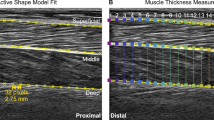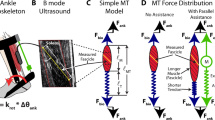Abstract
We present and evaluate a new approach to estimate calf muscle–tendon parameters and calculate calf muscle–tendon function during walking. We used motion analysis, ultrasound, and EMG data of the calf muscles collected in six young and six older adults during treadmill walking as inputs to a new optimal estimation algorithm. We used estimated parameters or scaled generic parameters in an existing approach to calculate muscle fiber lengths and activations. We calculated the fit with experimental data in terms of root mean squared differences (RMSD) and coefficients of determination (R2). We also calculated the calf muscle metabolic energy cost. RMSD between measured and calculated fiber lengths and activations decreased and R2 increased when estimating parameters compared to using scaled generic parameters. Moreover, R2 between measured and calculated gastrocnemius medialis fiber length and soleus activations increased by 19 and 70%, and calf muscle metabolic energy decreased by 25% when using estimated parameters compared to using scaled generic parameters at speeds not used for estimation. This new approach estimates calf muscle–tendon parameters in good accordance with values reported in literature. The approach improves calculations of calf muscle–tendon interaction during walking and highlights the importance of individualizing calf muscle–tendon parameters.



Similar content being viewed by others
References
Azizi, E., and T. J. Roberts. Biaxial strain and variable stiffness in aponeuroses. J. Physiol. 587:4309–4318, 2009.
Bhargava, L. J., M. G. Pandy, and F. C. Anderson. A phenomenological model for estimating metabolic energy consumption in muscle contraction. J. Biomech. 37:81–88, 2004.
Bolsterlee, B., S. C. Gandevia, and R. D. Herbert. Ultrasound imaging of the human medial gastrocnemius muscle: how to orient the transducer so that muscle fascicles lie in the image plane. J. Biomech. 49:1002–1008, 2016.
Crowninshield, R. D., and R. A. Brand. A physiologically based criterion of muscle force prediction in locomotion. J. Biomech. 14:793–801, 1981.
De Groote, F., T. De Laet, I. Jonkers, and J. De Schutter. Kalman smoothing improves the estimation of joint kinematics and kinetics in marker-based human gait analysis. J. Biomech. 41:3390–3398, 2008.
De Groote, F., A. L. Kinney, A. V. Rao, and B. J. Fregly. Evaluation of direct collocation optimal control problem formulations for solving the muscle redundancy problem. Ann. Biomed. Eng. 44:2922–2936, 2016.
De Groote, F., G. Pipeleers, I. Jonkers, B. Demeulenaere, C. Patten, J. Swevers, and J. De Schutter. A physiology based inverse dynamic analysis of human gait: potential and perspectives. Comput. Methods Biomech. Biomed. Eng. 12:563–574, 2009.
De Groote, F., A. Van Campen, I. Jonkers, and J. De Schutter. Sensitivity of dynamic simulations of gait and dynamometer experiments to hill muscle model parameters of knee flexors and extensors. J. Biomech. 43:1876–1883, 2010.
Delabastita, T., S. Bogaerts, and B. Vanwanseele. Age-related changes in Achilles tendon stiffness and impact on functional activities: a systematic review and meta-analysis. J. Aging Phys. Act. 2018. https://doi.org/10.1123/japa.2017-0359.
Delp, S. L., F. C. Anderson, A. S. Arnold, P. Loan, A. Habib, C. T. John, E. Guendelman, and D. G. Thelen. OpenSim: open-source software to create and analyze dynamic simulations of movement. IEEE Trans. Biomed. Eng. 54:1940–1950, 2007.
Farris, D. J., and G. A. Lichtwark. UltraTrack: software for semi-automated tracking of muscle fascicles in sequences of B-mode ultrasound images. Comput. Methods Programs Biomed. 128:111–118, 2016.
Franz, J. R., L. C. Slane, K. Rasske, and D. G. Thelen. Non-uniform in vivo deformations of the human Achilles tendon during walking. Gait Posture 41:192–197, 2015.
Franz, J. R., and D. G. Thelen. Imaging and simulation of Achilles tendon dynamics: implications for walking performance in the elderly. J. Biomech. 49:1403–1410, 2016.
Fukunaga, T., K. Kubo, Y. Kawakami, S. Fukashiro, H. Kanehisa, and C. N. Maganaris. In vivo behaviour of human muscle tendon during walking. Proc. Biol. Sci. 268:229–233, 2001.
Gerus, P., G. Rao, and E. Berton. Subject-specific tendon-aponeurosis definition in hill-type model predicts higher muscle forces in dynamic tasks. PLoS ONE 7:e44406, 2012.
Gerus, P., G. Rao, and E. Berton. Ultrasound-based subject-specific parameters improve fascicle behaviour estimation in Hill-type muscle model. Comput. Methods Biomech. Biomed. Eng. 5842:37–41, 2015.
Karamanidis, K., and A. Arampatzis. Mechanical and morphological properties of human quadriceps femoris and triceps surae muscle-tendon unit in relation to aging and running. J. Biomech. 39:406–417, 2006.
Lai, A., A. G. Schache, Y.-C. Lin, and M. G. Pandy. Tendon elastic strain energy in the human ankle plantar-flexors and its role with increased running speed. J. Exp. Biol. 217:3159–3168, 2014.
Lichtwark, G. A., K. Bougoulias, and A. M. Wilson. Muscle fascicle and series elastic element length changes along the length of the human gastrocnemius during walking and running. J. Biomech. 40:157–164, 2007.
Lichtwark, G. A., and A. M. Wilson. Interactions between the human gastrocnemius muscle and the Achilles tendon during incline, level and decline locomotion. J. Exp. Biol. 209:4379–4388, 2006.
Lichtwark, G. A., and A. M. Wilson. Optimal muscle fascicle length and tendon stiffness for maximising gastrocnemius efficiency during human walking and running. J. Theor. Biol. 252:662–673, 2008.
Mian, O. S., J. M. Thom, L. P. Ardigò, A. E. Minetti, and M. V. Narici. Gastrocnemius muscle-tendon behaviour during walking in young and older adults. Acta Physiol. 189:57–65, 2007.
Mohammadi, R., and C. P. Phadke. The impact of incline and speed of treadmill on ankle muscle activity in middle-aged adults. J. Bodyw. Mov. Ther. 21:306–313, 2017.
Monaco, V., and S. Micera. Age-related neuromuscular adaptation does not affect the mechanical efficiency of lower limbs during walking. Gait Posture 36:350–355, 2012.
Neptune, R. R., K. Sasaki, and S. A. Kautz. The effect of walking speed on muscle function and mechanical energetics. Gait Posture 28:135–143, 2008.
Passmore, E., A. Lai, M. Sangeux, A. G. Schache, and M. G. Pandy. Application of ultrasound imaging to subject-specific modelling of the human musculoskeletal system. Meccanica 2017. https://doi.org/10.1007/s11012-016-0478-z.
Patterson, M. A., M. J. Weinstein, and A. V. Rao. An efficient overloaded method for computing derivatives of mathematical functions in MATLAB. ACM Trans. Math. Softw. 39:17:1–17:36, 2013.
Rao, A. V., D. A. Benson, C. Darby, M. A. Patterson, C. Francolin, I. Sanders, and G. T. Huntington. GPOPS—II: a MATLAB software for solving multiple-phase optimal control problems using hp-adaptive Gaussian quadrature collocation methods and sparse nonlinear programming. ACM Trans. Math. Softw. 37:1–39, 2010.
Saule, C., and R. Giegerich. Pareto optimization in algebraic dynamic programming. Algorithms Mol. Biol. 10:1–20, 2015.
Sergi, G., C. Trevisan, N. Veronese, P. Lucato, and E. Manzato. Imaging of sarcopenia. Eur. J. Radiol. 85:1519–1524, 2016.
Stenroth, L., J. Peltonen, N. J. Cronin, S. Sipila, and T. Finni. Age-related differences in Achilles tendon properties and triceps surae muscle architecture in vivo. J. Appl. Physiol. 113:1537–1544, 2012.
Van Campen, A., G. Pipeleers, F. De Groote, I. Jonkers, and J. De Schutter. A new method for estimating subject-specific muscle–tendon parameters of the knee joint actuators: a simulation study network. Int. J. Numer. Methods Biomed. Eng. 30:969–987, 2014.
Van Rossom, S., C. R. Smith, L. Zevenbergen, D. G. Thelen, B. Vanwanseele, D. Van Assche, and I. Jonkers. Knee cartilage thickness, T1ρ and T2 relaxation time are related to articular cartilage loading in healthy adults. PLoS ONE 12:1–16, 2017.
Wächter, A., and L. Biegler. On the implementation of a interior-point filter line-search algorithm for large-scale nonlinear programming. Math. Programs 106:25–57, 2006.
Winter, D. A., and H. J. Yack. EMG profiles during normal human walking: stride-to-stride and inter-subject variability. Electroencephalogr. Clin. Neurophysiol. 67:402–411, 1987.
Zajac, F. E. Muscle and tendon: properties, models, scaling and application to biomechanics and motor control. Crit. Rev. Biomed. Eng. 17:359–411, 1989.
Conflicts of interest
No conflicts of interest have to be declared.
Author information
Authors and Affiliations
Corresponding author
Additional information
Associate Editor Elena S. Di Martino oversaw the review of this article.
Publisher's Note
Springer Nature remains neutral with regard to jurisdictional claims in published maps and institutional affiliations.
Electronic supplementary material
Below is the link to the electronic supplementary material.
Rights and permissions
About this article
Cite this article
Delabastita, T., Afschrift, M., Vanwanseele, B. et al. Ultrasound-Based Optimal Parameter Estimation Improves Assessment of Calf Muscle–Tendon Interaction During Walking. Ann Biomed Eng 48, 722–733 (2020). https://doi.org/10.1007/s10439-019-02395-x
Received:
Accepted:
Published:
Issue Date:
DOI: https://doi.org/10.1007/s10439-019-02395-x




